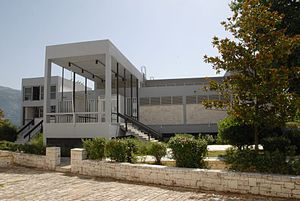
Ioannina, often called Yannena within Greece, is the capital and largest city of the Ioannina regional unit and of Epirus, an administrative region in north-western Greece. According to the 2011 census, the city population was 65,574, while the municipality had 112,486 inhabitants. It lies at an elevation of approximately 500 metres above sea level, on the western shore of Lake Pamvotis (Παμβώτις). Ioannina is located 410 km (255 mi) northwest of Athens, 260 kilometres southwest of Thessaloniki and 80 km east of the port of Igoumenitsa in the Ionian Sea.

Greek National Road 5 is a single carriageway road in western Greece. It connects Antirrio, at the north end of the Rio-Antirrio bridge, with Ioannina in northwestern Greece, passing through Agrinio and Arta. The southern part, between Amfilochia and Antirrio, is part of the European route E55. The northern part, between Ioannina and Amfilochia, forms the European route E951. It passes on the east side of the Ambracian Gulf. In the future much of the traffic that used this road will be diverted to the new A5 motorway, which has already taken over parts of the road. Νear Arta there is a 200m. tunnel which opened in 1969
Iliochori is one of the Zagori villages in northwest Greece. It is located in the municipal unit of Tymfi in the northern part of the regional unit of Ioannina. According to a local legend, the village was founded as Rasciana, on the river of the same name. However, that site was abandoned because of a lack of drinking water, and the inhabitants scattered to found Iliochori and the nearby town of Laista. Iliochori was traditionally an agricultural village, with husbandry and cultivation of barley and vetch being among its primary areas of economic activity. Viticulture was also prominent, and the village produced a wine, Dobrovino, that gave it its original name. Caravans leaving from Iliochori carried products from the region to the Balkans for trade. The town suffered severe damage in both World War II and the Greek Civil War and lost a large portion of its population during the 1940s as a result.
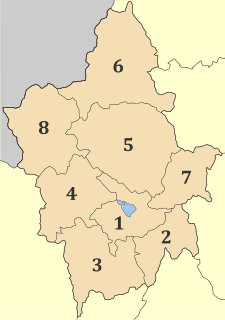
Ioannina is one of the regional units of Greece.
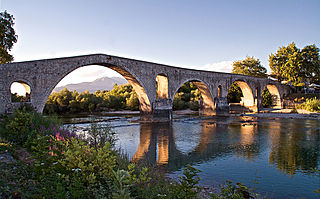
Arta is a city in northwestern Greece, capital of the regional unit of Arta, which is part of Epirus region. The city was known in ancient times as Ambracia. Arta is known for the medieval bridge over the Arachthos River. Arta is also known for its ancient sites from the era of Pyrrhus of Epirus and its well-preserved 13th-century castle. Arta's Byzantine history is reflected in its many Byzantine churches; perhaps the best known is the Panagia Paregoretissa, built about 1290 by Despot Nikephoros I Komnenos Doukas.

Ioannina International Airport is an airport located four kilometers from the city center of Ioannina, Greece. Its full name is Ioannina International Airport - King Pyrrhus.

Greek National Road 20 is a single carriageway road in northwestern Greece. It links the cities of Ioannina and Kozani via Konitsa and Siatista. It passes through the Ioannina, Kastoria and the Kozani regional units. Since the opening of the A2, it is no longer the fastest connection between Kozani and Ioannina. The section between Ioannina and Kalpaki is part of the European route E853.
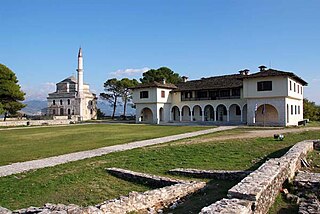
The Byzantine Museum of Ioannina is housed in one of the buildings of citadel of Ioannina, the capital of the Epirus region in northwestern Greece. The central section was built in the 1960s and originally functioned as a Royal Pavilion.

The Municipal Ethnographic Museum of Ioannina is a museum in Ioannina, Greece.

1912–1913 War Museum is a museum in Ioannina, Greece. The establishment was used as headquarters during the Balkan Wars. In 1950 the establishments were renovated and the museum was founded. The exhibition includes many paintings, armors, swords, guns and many other objects.
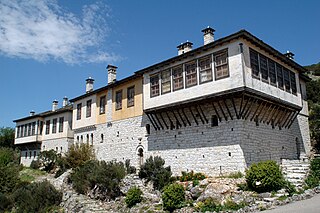
The Pavlos Vrellis Greek History Museum also known as Pavlos Vrellis Museum of Wax Effigies is a privately owned wax museum in Ioannina regional unit, Greece. It was set up by the sculptor Pavlos Vrellis in February 1983, and is the best known wax museum in Greece. The museum hosts 150 wax models in 37 themes, inspired by various events from Greek history.
The Tositsa Baron Museum of Metsovo, also known as the Tositsa Museum is a folk art museum in Metsovo, Ioannina, Greece.
The Ethnographic Museum of Pyrsogianni is a museum in the village Pyrsogianni, in the Mastorochoria area, in the Ioannina regional unit, Greece. It focuses on traditional stone masonry, and displays photographs, drawings, plans and tools.

The Kakavia or Kakavijë border crossing is a major road border crossing between southern Albania and northwestern Greece. On the Albanian side lies the village of Kakavijë, located in the Gjirokastër County, Dropull region. On the Greek side lies the village of Ktismata, in the Delvinaki municipality, Ioannina regional unit. The main road from Sarandë and Gjirokastër to Ioannina passes through this border crossing. The Greek National Road 22 connects Kakavia with the GR-20 at Kalpaki.
The University of Ioannina is a university located 5 km southwest of Ioannina, Greece. The university was founded in 1964, as a charter of the Aristotle University of Thessaloniki and became an independent university in 1970.
Gyftokampos is an area ιn the Zagori region, 58 km north of Ioannina. Its name is derived from the Greek "gyftos" (γύφτος), gypsy and "kampos" that means "field", and could be rendered in English translation as "gypsy lea". There used to be a hamlet called Nouka on this location which was also used by the Sarakatsani as pasture grounds. The area, located at the base of Mt Tymfi, has traditionally belonged to the village of Skamneli and it forms part of the municipality of Tymfi.
The National Stadium of Ioannina, more commonly known as Zosimades Stadium is a multi-purpose stadium based on Ioannina, Greece and named after the 18th-century Zosimades brothers, benefactors of the city. It is currently used mostly for football matches and is the home of PAS Giannina. The rock band Scorpions held a concert in the Zosimades Stadium in 2010.

Nikolaos Tzafouris(Greek: Νικόλαος Ζαφούρης η Τζαφούρης) 1468-1501), also Niccolo, Niccolò, Niccolö, Zafuri, Zafuris, was a Greek Renaissance painter. He was one of the founders of the Cretan School. He was influenced by Angelos Akotantos. His works influenced Emmanuel Tzanes, Elias Moskos, Georgios Klontzas and Theodoros Poulakis. Tzafouris was one of the most respected artists in Crete. His most notable work is Madre della Consolazione. The painting exhibits a combination of Byzantine and Italian styles. Another notable painter in Crete around the same time was Andreas Pavias. According to the Institute of Neohellenic Research, thirteen paintings are attributed to Tzafouris.

Georgios Nomikos was a Greek painter. He converted to Christianity from Judaism. He was a Greek Baroque painter. He was a member of the Cretan School and the Heptanese School. His contemporaries were Georgios Kastrofylakas, Theodore Poulakis, and Georgios Markou. He shared the same last name with famous Greek painter Demetrios Nomikos. He was active on the island of Zakynthos, Kefalonia Arta and Ioannina. Six of his paintings survived. Some of his frescos have survived in the destroyed church of Saint George in Lingiades, Ioannina. His work represents an evolution from the art of Angelos Akotantos and Elias Moskos to a more refined technique influenced by the art of the Ionion Islands.
